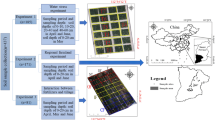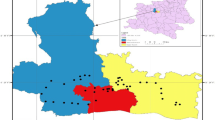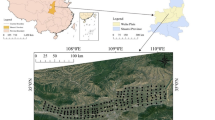Abstract
The estimation of nitrogen status non-destructively in rice was performed using canopy spectral reflectance with visible and near-infrared reflectance (Vis/NIR) spectroscopy. The canopy spectral reflectance of rice grown with different levels of nitrogen inputs was determined at several important growth stages. This study was conducted at the experiment farm of Zhejiang University, Hangzhou, China. The soil plant analysis development (SPAD) value was used as a reference data that indirectly reflects nitrogen status in rice. A total of 64 rice samples were used for Vis/NIR spectroscopy at 325–1075 nm using a field spectroradiometer, and chemometrics of partial least square (PLS) was used for regression. The correlation coefficient (r), root mean square error of prediction, and bias in prediction set by PLS were, respectively, 0.8545, 0.7628, and 0.0521 for SPAD value prediction in tillering stage, 0.9082, 0.4452, and −0.0109 in booting stage, and 0.8632, 0.7469, and 0.0324 in heading stage. Least squares support vector machine (LS-SVM) model was compared with PLS and back propagation neural network methods. The results showed that LS-SVM was superior to the conventional linear and non-linear methods in predicting SPAD values of rice. Independent component analysis was executed to select several sensitive wavelengths (SWs) based on loading weights; the optimal LS-SVM model was achieved with SWs of 560, 575–580, 700, 730, and 740 nm for SPAD value prediction in booting stage. It is concluded that Vis/NIR spectroscopy combined with LS-SVM regression method is a promising technique to monitor nitrogen status in rice.






Similar content being viewed by others
References
Arana, I., Jaren, C., Arazuri, S. (2005). Maturity, variety and origin determination in white grapes (Vitis vinifera L.) using near infrared reflectance technology. Journal of Near Infrared Spectroscopy 13, 349–357.
Borin, A., Ferrao, M. F., Mello, C., Maretto, D. A., & Poppi, R. J. (2006). Least-squares support vector machines and near infrared spectroscopy for quantification of common adulterants in powdered milk. Analytica Chimica Acta, 579, 25–32.
Broge, N. H., & Leblanc, E. (2001). Comparing prediction power and stability of broadband and hyperspectral vegetation indices for estimation of green leaf area index and canopy chlorophyll density. Remote Sensing of Environment, 76, 156–172.
Burges, C. J. C. (1998). A tutorial on support vector machines for pattern recognition. Data Mining and Knowledge Discovery, 2, 121–167.
Cen, H. Y., He, Y., & Huang, M. (2006). Measurement of soluble contents and pH in orange juice using chemometrics and Vis-NIRS. Journal of Agricultural and Food Chemistry, 54, 7437–7443.
Chauchard, F., Cogdill, R., Roussel, S., Roger, J. M., & Bellon-Maurel, V. (2004). Application of LS-SVM to non-linear phenomena in NIR spectroscopy: Development of a robust and portable sensor for acidity prediction in grapes. Chemometrics and Intelligent Laboratory Systems, 71(2), 141–150.
Chen, Q. S., Zhao, J. W., Fang, C. H., & Wang, D. M. (2007). Feasibility study on identification of green, black and Oolong teas using near-infrared reflectance spectroscopy based on support vector machine (SVM). Spectrochimica Acta Part A: Molecular Biomolecular Spectroscopy, 66, 568–574.
Cogdill, R. P., & Dardenne, P. (2004). Least-squares support vector machines for chemometrics: an introduction and evaluation. Journal of Near Infrared Spectroscopy, 2, 93–100.
Comak, E., Arslan, A., & Turkoglu, I. (2007). A decision support system based on support vector machines for diagnosis of the heart valve diseases. Computers in Biology and Medicine, 37, 21–27.
Despagne, F., & Massart, D. L. (1998). Neural networks in multivariate calibration. Analyst, 123, 157R–178R.
Ehsani, M. R., Upadhyaya, S. K., & Slaughter, D. (1999). A NIR technique for rapid determination of soil mineral nitrogen. Precision Agriculture, 1, 217–234.
Fassio, A., & Cozzolino, D. (2003). Non-destructive prediction of chemical composition in sunflower seeds by near infrared spectroscopy. Industrial Crops and Products, 20, 321–329.
Feng, W., Yao, X., Zhu, Y., Tian, Y. C., & Cao, W. X. (2008). Monitoring leaf nitrogen status with hyperspectral reflectance in wheat. European Journal of Agronomy, 28, 394–404.
Guo, G., Li, S. Z., & Chan, K. L. (2001). Support vector machines for face recognition. Image and Vision Computing, 19, 631–638.
Helland, I. S., Naes, T., & Isaksson, T. (1995). Related versions of multiple scatter correction. Chemometrics and Intelligent Laboratory Systems, 29, 233–241.
Hyvarinen, A., & Oja, E. (2000). Independent component analysis: Algorithms and applications. Neural Network, 13, 411–430.
Hyvarinen, A., Karhunen, J., & Oja, E. (2001). Independent component analysis. New York: Wiley.
Lee, T. W. (1998). Independent component analysis: Theory and application. Boston: Kluwer.
Lee, Y. J., Yang, C. M., Chang, K. W., & Shen, Y. (2008). A simple spectral index using reflectance of 735 nm to assess nitrogen status of rice canopy. Agronomy Journal, 100, 205–212.
Li, X. L., & He, Y. (2009). Evaluation of least squares support vector machine regression and other multivariate calibrations in determination of internal attributes of tea beverages. Food and Bioprocess Technology. doi:10.1007/s11947-008-0101-y.
Liu, F., He, Y., Wang, L. & Sun, G. M. (2009a). Detection of organic acids and PH of fruit vinegars using near-infrared spectroscopy and multivariate calibration. Food and Bioprocess Technology. doi:10.1007/s11947-009-0240-9.
Liu, F., Jiang, Y. H., & He, Y. (2009b). Variable selection in visible/near infrared spectra for linear and nonlinear calibrations: A case study to determine soluble solids content of beer. Analytica Chimica Acta, 635, 45–52.
Lu, C., Van Gestel, T., Suykens, J. A. K., Van Huffel, S., Vergote, I., & Timmerman, D. (2003). Preoperative prediction of malignancy of ovarian tumors using least squares support vector machines. Artificial Intelligence in Medicine, 28(3), 281–306.
Martens, H., & Naes, T. (1989). Multivariate calibration. Chichester: Wiley.
Mello, C., Poppi, R. J., de Andrade, J. C., & Cantarella, H. (1999). Pruning neural network for architecture optimization applied to near-infrared reflectance spectroscopic measurements. Determination of the nitrogen content in wheat leaves. Analyst, 124, 1669–1674.
Min, M., Lee, W. S., Kim, Y. H., & Bucklin, R. A. (2006). Nondestructive detection of nitrogen in Chinese cabbage leaves using VIS-NIR spectroscopy. Hortscience, 41, 162–166.
Moody, J. E. (1992). The effective number of parameters: An analysis of generalization and regularization in nonlinear learning systems. In J. E. Moody, S. J. Hanson, & R. P. Lippmann (Eds.), Advances in neural information processing systems 4 (pp. 847–854). San Mateo: Kaufmann.
Noh, H., Zhang, Q., Shin, B., Han, S., & Feng, L. (2006). A neural network model of maize crop nitrogen stress assessment for a multi-spectral imaging sensor. Biosystems Engineering, 94, 477–485.
Shao, Y. N., He, Y., & Hu, X. Y. (2007). Optical system for tablet variety discrimination using visible/near-infrared spectroscopy. Applied Optics, 46, 8379–8384.
Stroppiana, D., Boschetti, M., Brivio, P. A., & Bocchi, S. (2009). Plant nitrogen concentration in paddy rice from field canopy hyperspectral radiometry. Field Crops Research, 111, 119–129.
Suykens, J. A. K., & Vanderwalle, J. (1999). Least squares support vector machine classifiers. Neural Processing Letters, 9, 293–300.
Suykens, J. A. K., Van Gestel, T., De Brabanter, J., De Moor, B., & Vandewalle, J. (2002). Least squares support vector machines. Singapore: World Scientific.
Vapnik, V. (1998a). Statistical learning theory. New York: Wiley.
Vapnik, V. (1998b). The support vector method of function estimation. In J. A. K. Suykens & J. Vandewalle (Eds.), Nonlinear modeling: advanced black-box techniques (pp. 55–85). Boston: Kluwer.
Widyanto, M. R., Novuhara, H., Kawamoto, K., Hirota, K., & Kusumoputro, B. (2005). Improving recognition and generalization capability of back-propagation NN using a self organized network inspired by immune algorithm (SONIA). Applied Soft Computing, 6, 72–84.
Xue, L. H., Cao, W. X., Luo, W. H., Dai, T. B., & Zhu, Y. (2004). Monitoring leaf nitrogen status in rice with canopy spectral reflectance. Agronomy Journal, 96, 135–142.
Yang, X. H., Wang, F. M., Huang, J. F., Wang, J. W., Wang, R. C., Shen, Z. Q., et al. (2009). Comparison between radial basis function neural network and regression model for estimation of rice biophysical parameters using remote sensing. Pedosphere, 19, 176–188.
Zhang, X., Yan, W. W., & Shao, H. H. (2008). Nonlinear multivariate quality estimation and prediction based on kernel partial least squares. Industrial & Engineering Chemistry Research, 47, 1120–1131.
Acknowledgements
This study was supported by the National Science and Technology Support Program (2006BAD10A09), the 863 Project of China (2007AA10Z210), Natural Science Foundation of China (Project No: 30671213), National Special Public Sector Research of Agriculture (200803037), and Natural Science Foundation of Zhejiang (Y307119).
Author information
Authors and Affiliations
Corresponding authors
Rights and permissions
About this article
Cite this article
Shao, Y., Zhao, C., Bao, Y. et al. Quantification of Nitrogen Status in Rice by Least Squares Support Vector Machines and Reflectance Spectroscopy. Food Bioprocess Technol 5, 100–107 (2012). https://doi.org/10.1007/s11947-009-0267-y
Received:
Accepted:
Published:
Issue Date:
DOI: https://doi.org/10.1007/s11947-009-0267-y




